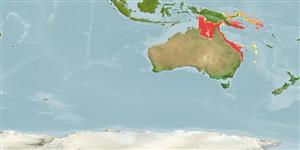>
Eupercaria/misc (Various families in series Eupercaria) >
Nemipteridae (Threadfin breams, Whiptail breams)
Etymology: Pentapodus: Greek, pente = five + Greek, pous = feet (Ref. 45335).
More on author: Günther.
Environment: milieu / climate zone / depth range / distribution range
Ecologia
marino associati a barriera corallina; distribuzione batimetrica 10 - 70 m (Ref. 90102). Tropical; 3°S - 30°S, 135°E - 165°E (Ref. 3810)
Western Pacific: northeastern Australia, southern Papua New Guinea, Solomon Islands and the Philippines. This species has been previously confused with Pentapodus setosus by most authors.
Size / Peso / Age
Maturity: Lm ? range ? - ? cm
Max length : 30.0 cm TL maschio/sesso non determinato; (Ref. 9710); common length : 15.0 cm SL maschio/sesso non determinato; (Ref. 3810)
Spine dorsali (totale): 10; Raggi dorsali molli (totale): 9; Spine anali 3; Raggi anali molli: 7. Head scales reaching forward to or almost to level of posterior nostrils. Suborbital naked. Lower limb of preopercle naked. Pelvic fins short, not reaching to level of anus. Upper lobe of caudal fin produced into a very long trailing yellowish-brown filament. Axillary scale present. Color: Upper body pale brownish, lower whitish. Presence of three bluish stripes across snout, first joining eyes behind nostrils, second in front of nostrils, third from eye to tip of snout. A yellow stripe from behind eye to upper base of pectoral fin. A yellow stripe from middle of upper lip, beneath eye to below pectoral fin.
Found near reefs. Juveniles in rubble areas (Ref. 9710). Solitary or in small groups (Ref. 90102). Feeds on small fishes, crustaceans and polychaetes (Ref. 9785).
Life cycle and mating behavior
Maturità | Riproduzione | Deposizione | Uova | Fecundity | Larve
Russell, B.C., 1990. FAO Species Catalogue. Vol. 12. Nemipterid fishes of the world. (Threadfin breams, whiptail breams, monocle breams, dwarf monocle breams, and coral breams). Family Nemipteridae. An annotated and illustrated catalogue of nemipterid species known to date. FAO Fish. Synop. 125(12):149p. Rome: FAO. (Ref. 3810)
IUCN Red List Status (Ref. 130435)
Threat to humans
Harmless
Human uses
Pesca: pesca di sussistenza
Informazioni ulteriori
Nomi ComuniSinonimiMetabolismoPredatoriEcotossicologiaRiproduzioneMaturitàDeposizioneSpawning aggregationFecundityUovaEgg development
BibliografiaAcquacolturaProfilo di acquacolturaVarietàGeneticaElectrophoresesEreditarietàMalattieElaborazioneNutrientsMass conversion
CollaboratoriImmaginiStamps, Coins Misc.SuoniCiguateraVelocitàModalità di nuotoArea branchialeOtolithsCervelliVista
Strumenti
Special reports
Download XML
Fonti Internet
Estimates based on models
Preferred temperature (Ref.
123201): 24.5 - 28, mean 26.5 °C (based on 150 cells).
Phylogenetic diversity index (Ref.
82804): PD
50 = 0.5002 [Uniqueness, from 0.5 = low to 2.0 = high].
Bayesian length-weight: a=0.01479 (0.00706 - 0.03101), b=2.97 (2.80 - 3.14), in cm total length, based on LWR estimates for this (Sub)family-body shape (Ref.
93245).
Trophic level (Ref.
69278): 3.7 ±0.54 se; based on food items.
Resilienza (Ref.
120179): Alto, tempo minimo di raddoppiamento della popolazione meno di 15 mesi (Preliminary K or Fecundity.).
Fishing Vulnerability (Ref.
59153): Low vulnerability (20 of 100).
Nutrients (Ref.
124155): Calcium = 52.6 [31.8, 103.4] mg/100g; Iron = 0.633 [0.310, 1.558] mg/100g; Protein = 19.1 [17.2, 20.8] %; Omega3 = 0.158 [0.095, 0.265] g/100g; Selenium = 32.1 [19.5, 57.2] μg/100g; VitaminA = 75 [22, 213] μg/100g; Zinc = 1.18 [0.82, 1.68] mg/100g (wet weight);
